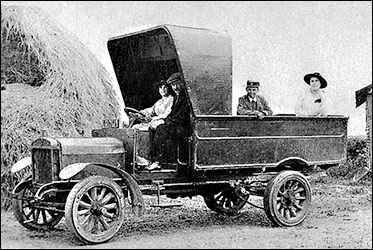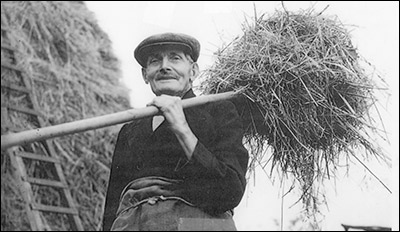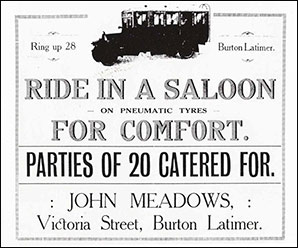|
My grandfather, John Meadows, was born at Titchmarsh, near Thrapston, in 1868 and had 10 brothers and sisters. He left school at the age of eleven and worked for local farmers where his first job was scaring birds!. He went on to tend sheep which he would walk to the markets in Thrapston and Kettering. Later, he worked in various trades: On the railways, in brewing and the brickyard; ironstone milling.
After his marriage, in 1890, to Sabina Wright, of Peterborough, they moved to London where they kept a Fish and Chip shop. About 1897, they returned to Northamptonshire and settled in Burton Latimer. They lived in a large Farmhouse on the corner of Church Street and Cranford Road which later became the home of Frank and Dorothy Attfield. In my grandparent’s day, the house was divided and lived in by two families.
John and Sabina had four children: John, born in 1893, Lilian (my mother) born in 1900, Annie, born in 1902 and James (Jim) who was born in 1906. The family were Baptists. My grandfather became a coal merchant and had his own wagons at Burton Latimer railway station. He also carted flour and corn for Wallis’ Mill, now Weetabix, and rented a local field where he grew crops and kept sheep and cattle. He also kept his horse in a paddock that was situated at the corner of Victoria Street and Station Road. In 1923, Mr Albert Fox built a house, on the site of the paddock, which is now known as “Latimer Grange Residential Home."
1900 saw John Meadows build two houses: 6 and 8 Victoria Street. Number 6 Victoria Street was for his occupation whilst number 8 became the home of Mrs Clara Mason. She was a lovable, motherly soul who would bring you into the world, and also see you out!! She died in 1973 having attained the grand old age of 99.
Mrs Jacques, the wealthy wife of the Rector, Reverend W B Jacques (1895-1911) sold my grandfather an acre of land, off Victoria Street, for £50 and in 1912. He build Regent House and kept his pigs and hens on the surrounding land. The large double fronted property cost £450 to build and remained in the family until 1979. During the course of its construction one of the two workmen employed on the job apparently got drunk and was locked up for punching the local policeman! The house gave its name to Regent Road when Victoria Street was linked to Bridle Road in 1959.
A photo from 1971 showing Regent House.
The lane along the south side leads to the former garages and workshops of Meadows Coaches
|
|
|
In 1923 my grandmother, Sabina, died at the age of 52 from diabetes and two years later John built a bungalow in Barton Seagrave village. The gardens of the bungalow bordered the remains of the former moat of the castle keep and during excavations human skeletons were unearthed.
My grandfather bought a motor lorry, or truck, in 1917 for use in connection with his cartage work. This was driven by his daughter Lilian, my mother, and I still have her first driving licence, dated 1917. It is a large certificate the size of an old £5 note. This vehicle became the first bus, locally, after the Great War when a covered top and wooden seat were bolted to the lorry body structure. The seats were placed around the sides so that passengers faced inwards. In those early days the bus had difficulty negotiating Barton Hill and passengers would have to get off, by Barton Hall, and walk up the hill. Sometimes they would even have to give the bus a helpful push!
 |
| The Meadows truck was in use as farm transport and was converted with benches to carry passengers when needed. |
|
My mother also drove the first bus along Polwell Lane when the road had been made suitable for traffic. She took the corner by Station Road, where Alumasc now stands, too wide and ended up the ditch but the passengers simply got off, righted the bus and, with no damage having been done, they boarded again to continue their journey to Kettering.
A second vehicle, called PANSY, was acquired in 1920 which provided services to Kettering and Wellingborough and Thrapston. By 1924 there were at least five more added to the fleet. Some of these buses were bought new and others were second hand. A large, brick, garage was built at the rear of Regent House to house and repair the vehicles. This building still survives today.
A partnership was formed, in 1924, with brothers Harold and Walter Frost, of Kettering, and the business traded as Meadows and Frost. A garage was built in Hallwood Road in Kettering. Known as Kingsley Garage, it also housed the company’s office and was where the buses were services and repaired. During the next six years the fleet consisted of ten buses which provided services between Burton Latimer and Dalkeith Place and Kingsley Avenue and Corby via the villages. Worker’s buses were also contracted with William Timpson’s factory at 2/- for a weekly ticket and with the steel works at Corby. There were excursion coaches too and these would run, weekly, to Great Yarmouth, Bournemouth and to Huntingdon Races during the season. Walter Frost went on to marry Annie in 1925.
The partnership of Meadows and Frost was dissolved in 1930 when the Frosts formed a separate company and John and son, Jim, formed J Meadows and son. They ran a bus service between Kettering and Huntingdon each evening, departing form Kettering at 6pm. Part of the service covered Higham Ferrers and Chelveston with conductors only on duty at the weekends. At other times the driver would collect the fare and keep the takings in a large leather bag. No tickets were issued in those earlier years and the buses ran all day, until midnight at weekends.
John Meadows also had a 7 seater Daimler which he ran as a Taxi. He purchased it in London and it was reputed to have been previously owned by a “Royal”. He sold his business out to the United Counties Omnibus Company in 1938. Local men who were employed by him included Bob Phillips, Bill Wright, Percy Knowles, Bill Smith, Charlie Henson and Laurie Plowman.
Around 1936 the United Counties employees went on strike and pickets even attacked private buses and smashed windows if they had not been boarded up. As a boy I can remember that pickets stopped one bus in Station Road, by the entrance to Weetabix, pulled off the driver and pushed him over the bridge into the river Ise.
In 1935 my grandfather was able to purchase the land at Hogs Hole, between Burton Latimer and Isham, that he had rented for some years from Mr James Osborne. This consisted of about 18 acres and included half the spinney. The entrance to the farm was off Bridle Road and here he grew crops and kept cattle. In the 1960’s the top field, known as Long Close and consisting of five acres, was sold and is now built on by the houses in Queensway. At the bottom end of this field was the spring at the former Urban Council bought for £20, intending to construct a Swimming Pool, but the war started and the project was abandoned. My grandfather rented this small piece of land by the spring back for a shilling a year as the Council was unwilling to sell it back. When development took place it was valued at £800.
John Meadows, who had three marriages, continued to drive his car, a 1936 Austin 10, until he was 90. He died in 1961, after a short illness, at his home in Barton Seagrave at the age of 93. He still had all his hair, his own teeth and did not wear glasses; lived almost entirely on a daily basin of bread and milk or bread and gravy and carried his money in a leather bag tied to his belt.
My grandfather’s motto for a long and healthy life was “No smoking or drinking, plenty of outdoor activity and a good night's sleep”.
 |
|
John Meadows, aged 85 in 1953
|
|
|



